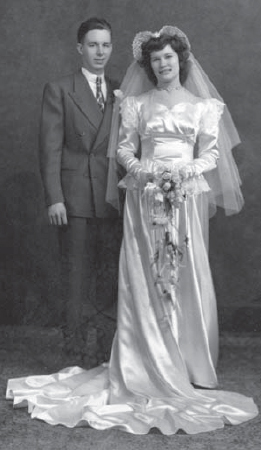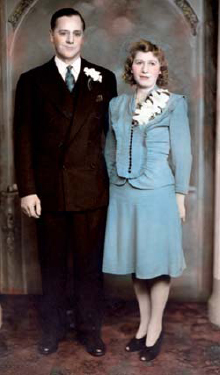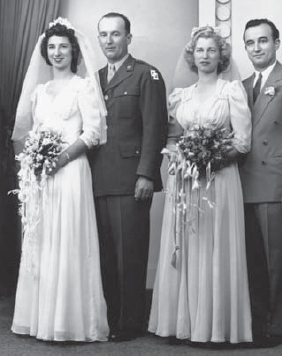
ALTHOUGH World War II began in 1939 when Germany invaded Poland, America did not enter the war until December 8, 1941, after Japan bombed Pearl Harbor. The attack on Pearl Harbor generated enough anger, fear, and hatred to unite Americans more strongly than at any time in history.
Once war was declared, the federal government was given the power to allocate raw materials, establish priorities for production, and ration supplies. Basically, the government told businesses what to make, set production quotas for them, and could even take over plants if those quotas were not met.

This typical “Utility” dress pattern fit into the L-85 restrictions on clothing during the war. Dresses typically had broad shoulders, slender bodices, and A-line skirts.

This lovely bride wears a mid-1940s bridal dress style with shoulder emphasis and short lace peplum attached at the waistline.

The bride wears her good dress and hat, and so does the bridesmaid, in this 1942 wartime wedding.

This Downers Grove, Illinois, bride wears her good dress, matching puffed net headpiece,
While World War II raged, the home front became another battleground in the war as Americans accepted shortages of consumer products, adhered to rationing restrictions, bought war bonds, and worked overtime to produce the weapons and supplies needed by the troops. Conducting the war required huge amounts of petroleum, steel, rubber tires, wool, and other vital raw materials, as well as meat, bread, butter, coffee, and other foodstuffs. This resulted in food rationing at home as the nation struggled to feed not only American troops but Allied soldiers and the victims of the war in Europe as well.
Government rationing of tires and gasoline drastically reduced driving. With no new cars being manufactured, people were challenged with keeping their cars patched and running. Ride sharing was one solution, and mass transportation was another as people jammed into buses and trains.
Rationing was complicated and confusing for both shoppers and merchants. Each person, adults and children alike, was issued a ration book with stamps worth various points that authorized them to buy scarce items. Once people used up their stamps for such items as meat and gasoline, they were out of luck because they could not buy more without the proper ration stamps. The average gasoline ration was three gallons per week, the yearly butter ration was twelve pounds per person (25 percent less than normal), and new leather shoes were restricted to three pairs per year.
Because of the war effort, unemployment fell drastically and workers earned higher wages than they had in years. The jobs created by the war gave people money to spend for the first time in years since to the Great Depression, but with rationing and shortages, it was impossible to buy what they desired. Subsistence living, which had started during the Depression, continued throughout the war.
With so many men off to war, women stepped in to fill the labor shortages, with 7 million of them joining the workforce during the war. “Rosie the Riveter” symbolized these women, who helped to build the planes, tanks, ships, and guns that fought the war. World War II gave women the opportunity to hold traditionally male jobs such as miners, meat packers, cab drivers, lumberjacks, welders, and even railroad workers. To do these jobs, women began wearing slacks to work, starting a fashion trend. They also wore scarves on their heads to keep their hair out of the machinery.
Although women were not allowed to fight as soldiers, in 1942 the Women’s Army Corps (WAC), the Navy’s Women Accepted for Volunteer Emergency Service (WAVES), and the Women’s Air Force Service Pilots (WASP) were created to allow women to fly planes, drive trucks, nurse the sick and wounded, and perform other noncombat jobs, freeing men for combat.
Fashion was greatly influenced by World War II. Paris had long been the source of fashion trends before the war. But when the Germans defeated France and occupied Paris in 1940, the German government took over the fashion houses and restricted their sales to only their Axis allies and neutral countries. American and British designers were left to fill the void. New styles featured wide, padded shoulders, narrow waists, and draping over skirts.

This Toledo, Ohio, bride and her bridesmaid wear matching dresses with sweetheart necklines, gathered bodices, and elbow-length sleeves.
In addition to food and gas rationing, in 1942 the United States issued restrictions on the amount of fabric that could be used to make dresses, jackets, trousers, and skirts. This list of do’s and don’ts for manufacturers was called “L-85.” Day dresses were limited to 3.5 yards of fabric; skirts could be no more than 78 inches around, and the number of buttons, pleats, and pockets also was limited. Trimmings could be no more than 3/8 of a yard, and the height of high heels was fixed at 1.5 inches. Metal zippers were banned, so hooks and eyes and snaps were used instead. Corset manufacturing also was limited, so women were encouraged to go without a girdle. Finally, nylon and silk were needed to make parachutes, so women dealt with the shortage of sheer stockings by using an eyebrow pencil to paint an imitation seam up the backs of their legs to simulate the seam of regular stockings.
The dresses and patterns that fit into L-85 restrictions were called “Utility” dresses. Bodices fit close to the body with a natural waistline and a straight or A-line skirt. Seams and slight gathering in unusual parts of the dress replaced the attached decorations of previous styles. These restrictions had the effect of “freezing” fashion at the 1940 styles.
Maternity and wedding gowns did not have all these restrictions, although the scarcity of materials limited them to rayon satins, crepes, and taffetas in slender styles, with very few decorations. One style of bridal dress that was popular for both brides and bridesmaids had a gathered seam down the center front of the bodice.
The start of World War II resulted in many hurried weddings as couples married either to prevent the groom from being drafted into the service or to wed before the man shipped off to the war. Brides often only had time to get a good dress to wear for their quickie wedding. (Later in the war, being married would not solve the draft issue.)
Although bridal gowns were rarely worn in these quickie weddings, brides often wore embellished dresses. Smocked yokes, gathered bodices, narrow belts, and slightly pleated skirts were not uncommon. Bridesmaids often wore dresses with smocking on the bodice for decoration, bows at the neckline, wide belts, and stitched pleat skirts. A small matching straw hat might sport a feather or other decoration to liven it up.

When women saw movie stars on the screen wearing hats like the ones these actresses are wearing in Four Jills in a Jeep, they copied them, even in their bridal headpieces.
Fashionable two-piece dresses, often with a yoke piece creating the front of the bodice, padded shoulders, and pleated fabric, or dressier suits also were popular, usually paired with an A-line skirt. Hats, gloves, and low-heeled shoes usually were worn by brides and bridesmaids alike. The bridal party often accessorized their otherwise simple dresses with boutonnieres and corsages.
Of course, not all brides were married in quick ceremonies. Some brides did, in fact, have both the time and resources for a more traditional event, complete with gown, veil, and flowers. Typical bridal gowns of the early 1940s often featured bodices with puffy sleeves that ended below the elbow. Skirts were gathered, reaching just to the floor or with a train. Bridal dresses were often made of satin, crepe, chiffon, or taffeta, while velvet was used for some bridesmaids’ dresses. At the beginning of the 1940s, headpieces were often adorned with small flowers on top of her veil.

This wedding party from May 16, 1942, wears headpieces copied from Hollywood. This bride’s dress has a broad satin collar over lace fabric. The bridesmaids all wear similar dresses, but with three different kinds of skirts.

This young woman was photographed on January 7, 1945, sporting a typical mid-1940s dress with gathered center on the bodice and double-layered peplum over the skirt.
Hollywood fashions continued to have a big influence on women, and many fashion trends started in the movies. One trend in particular that showed up in bridal fashions in the mid-1940s was the hat. Everyday hats were either small and worn perched on the front of the head or large-brimmed and worn sitting on the back of the head to frame the face. A woman may not have had an exciting dress because of the war restrictions, but there were no restrictions on hats, so they got pretty wild and perked up their wearers.

The bridesmaids in this military wedding are wearing large hats in gathered chiffon that match their dresses. The bride’s headpiece is starched lace with veiling.
Bridal headpiece fashions were often styled to resemble hats seen in the movies. Both brides and bridesmaids wore hats of straw or fabric, decorated by bows, flowers, or veils. Another popular style featured the headpiece being above the head, often in satin or velvet over a wire frame. Some brides wore headpieces of starched lace and a two-tiered veil.
During World War II, bridal bouquets were made of whatever flowers were available, and roses, chrysanthemums, lilies, Shasta daisies, and even gladiolas were used. As bouquets got smaller, they were made to look larger with lace and net gathered around them. Wide, net ribbons and bouquet waterfalls were added to increase their size, too.

This bride carries a white gladiola bouquet and wears a sheer dress with rows of lace for decoration. A headpiece of wax flowers on a wire frame features a long, two-tiered veil that covers her large train.

The maid of honor and bridesmaids have sheer lace peplums decorating their plain crepe dress skirts and matching elbow-length fingerless gloves. The bride’s satin dress has lace appliqués around the neckline.

This Chicago bride’s satin dress has a low neckline filled in by a sheer fabric.
In the mid-1940s fashion styles changed with the addition of peplums, short layers of fabric draped over the skirt. Peplums were draped all around the woman’s hips, or shorter in front and longer in back. The peplum fashion trend was featured in bride and bridesmaids styles, often in lace fabric. At the same time, elbow-length fingerless gloves of dress fabric were seen in bridal fashions.
World War II ended with VJ Day on August 15, 1945. Soon after, clothing restrictions were lifted and fashion changes started again. Paris designer Christian Dior’s “New Look” fashions featured a decidedly more feminine look that accentuated the bust, with nipped-in waist and fuller, longer skirts, and they influenced fashion in Europe and America. This was a welcome change from the severe military look during the war.
By 1945, there was a change in bridal fashions, too. Bodices became simpler with low necklines filled with sheer fabric for modesty. Wide, flat collars and long sleeves became common, as did appliqués. Satin dresses with sheer fabric-filled bodices, pointed waistlines, long sleeves with puffy tops and close-fitting bottoms, and gathered skirts were typical of postwar gowns. Bridesmaids’ dresses often featured bodices with open necklines edged with wide ruffles, gathered center panels, short puffy sleeves, dropped waistlines and gathered skirts drawn up at the bottom and decorated with fabric flowers. Long faux sleeves that matched their dresses also were common.

This wedding party shows the change in wedding fashions after World War II. The bridesmaids are wearing long faux sleeves that match their dresses.
As GIs returned home after World War II, there was a rush to get married and start families. This resulted in a jump in the birth rate that remained high for the next decade—the “baby boom.” These new families needed their own homes, and new suburbs took shape as builders hurried to build small, affordable starter homes for returning veterans.
After World War II, industries began manufacturing consumer goods again. Industry in Britain and Europe had been severely damaged during the war, but American industry did not suffer as much, so it geared up and began providing goods to the rest of the world. This resulted in a period of well-paying jobs and security for American workers that would last through the 1950s.

The bridesmaids in this Moline, Iowa, wedding party are wearing fashionable dresses for 1949. The bridesmaids have double-layer flat collars around their sheer-filled necklines.